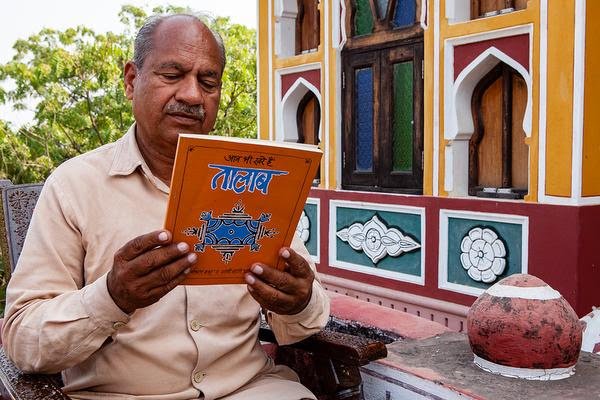Laporiya is a small village nestled in the heart of Pink City Jaipur. Once famine struck, this village is now drought proof and poverty free. All thanks to Lakshman Singh, who with his ingenious method of rainwater harvesting has benefitted more than 3.5 lakh people.
After studying till STD 5 in Laporiya, Lakshman went to Jaipur in the year 1969 to continue his schooling. “That was a very bad phase in the village. The wells ran dry and there was a situation of famine,” he says in an interview with KenFolios.

People would fight with each other over water as the only pond in the village became dysfunctional and there was no agriculture. Lakshman’s parents could not afford his studies so he dropped out of STD 10 and returned to Laporiya.
To continue his studies, Lakshman would bring books from nearby libraries. He would seek various methods to solve the problem of water crisis in the village. “We went to the government authorities for help but they did not give any proper answer,” he recalls.
Lakshman was 18-year-old when he realized that the only way to turn Laporia’s misfortune was to repair the bund (mud embankment) along the dry pond, which had remained broken for 230 years. His friends joined him and in the year 1977, Gram Vikas Navyuvak Mandal Laporia (GVNML) was formed to alleviate the hardships.
“We decided to reconstruct the pond, plant trees, cultivate more crops, and start a night school for children,” tells Lakshman. Eventually, 80 people joined and Lakshman came up with his ingenious rainwater harvesting technique, The Chauka System (see the photo above). A chauka is a rectangular enclosure surrounded on three sides by earthen bunds that are constructed from soil dug out of smaller rectangular borrow pits. They were built uphill the village and its ponds and wells. The water collected replenished underground water aquifers, gradually feeding the ponds and wells.
Lakshman’s work started growing and with the help of his team, he initiated The Chauka System in 558 villages. They planted hundreds of trees and made a ‘Praakritik Aawas’ for all the birds, animals, insects, and living creatures to grow.
However, Lakshman had to face challenges at every step. When people started cutting trees, GVNML made a rule that they have to plant two trees for every tree they cut. Some of the villagers then went to the police to complaint. A warrant was filed against Lakshman who was asked, “Aap kaun si dhaara k tehet aisa kaam kar rahe ho?” He was asked to discontinue his work. “I said that I will continue to work for my village. If you want to punish me, you can go ahead,” tells Lakshman.
Soon enough, his work started speaking for him and he got support from many people. The villagers started cooperating and by 1984, the ponds and wells were rejuvenated and were irrigating 1,800 acres of farmland. Crops were harvested twice a year and Laporiya became self-sufficient. The villagers started dairy farming and today, they get 24,000 liters of milk from one village.
GVNML now has around 80,000 members and employs 45 staff in four offices around Rajasthan, predominantly Jaipur and Tonk districts.

Lakshman says that everyone should at least try to plant trees around themselves. “Agar humne yeh nahi samjha toh manushya ko khatra jaruru hoga (If we don’t understand this then the entire human race will suffer),” he says as he signs off.
From an impoverished, drought-afflicted, conflict-ridden village, Laporiya became a symbol of rural renewal just when one person took a step forward. It developed into a self-sufficient oasis of agricultural. Lakshman Singh has changed the future of not just his village but many villages in Rajasthan with his hard work and determination.
If you like this story, share it and spread positivity. Tell us your views by writing in the comment box below. We read each one of them.
Looking For Startup Consultants ?
Call Pursho @ 0731-6725516
Telegram Group One Must Follow :
For Startups: https://t.me/daily_business_reads







